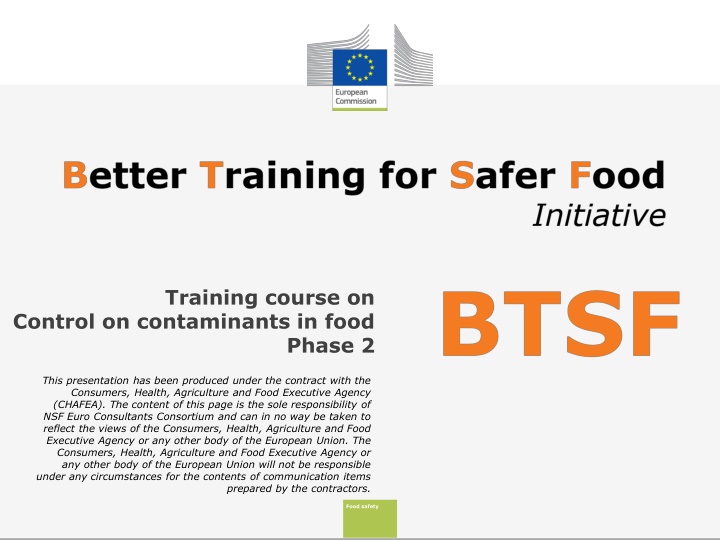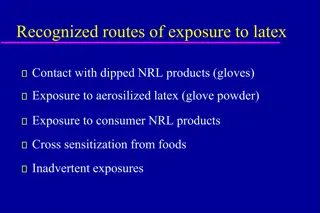
Control Contaminants in Food: Training Course Phase 2 Highlights
Explore the essential role of EU-RLs and EURLs/NRLs in ensuring food safety, harmonizing diagnostic tools, and facilitating trade issues. Learn about the responsibilities of EU Reference Laboratories and the regulations governing contaminants in food.
Download Presentation

Please find below an Image/Link to download the presentation.
The content on the website is provided AS IS for your information and personal use only. It may not be sold, licensed, or shared on other websites without obtaining consent from the author. If you encounter any issues during the download, it is possible that the publisher has removed the file from their server.
You are allowed to download the files provided on this website for personal or commercial use, subject to the condition that they are used lawfully. All files are the property of their respective owners.
The content on the website is provided AS IS for your information and personal use only. It may not be sold, licensed, or shared on other websites without obtaining consent from the author.
E N D
Presentation Transcript
Training course on Control on contaminants in food Phase 2 This presentation has been produced under the contract with the Consumers, Health, Agriculture and Food Executive Agency (CHAFEA). The content of this page is the sole responsibility of NSF Euro Consultants Consortium and can in no way be taken to reflect the views of the Consumers, Health, Agriculture and Food Executive Agency or any other body of the European Union. The Consumers, Health, Agriculture and Food Executive Agency or any other body of the European Union will not be responsible under any circumstances for the contents of communication items prepared by the contractors. Food safety
5.5. EURLs/NRLs Reminders on EURLs and NRLs functions. Methods and laboratory accreditation Roles of NRLs in the control of contaminants, beyond analyses: contribution to design of sampling programmes, establishment of sampling methods, sample size and acceptance criteria Mr. Carlo Brera 2 Food safety
Background Measurements are the key tool for guaranteeing food safety along the agri-food chain, monitoring not only products that are purchased within national borders, but also performing import/export control in harbours and at EU borders. In order to keep the costs of monitoring affordable, duplication and multiplication of analytical work should be avoided. The need of a Reference Organisation deputed to harmonise the principles, diagnostic tools, operating procedures, is a MUST for targeting the CAs mission. An additional target is the contributing at the resolution of disputes when disagreements occur. facilitation of trade issues, 3 3 Food safety
EU-RLs mission AIM High quality and uniformity of analytical results Use of validated methods Availability of reference materials Organization of PT Training course 4 4 Food safety
EU-RLs - Contaminants Commission Regulation (EU) 2018/192 1. Mycotoxins and Plant Toxins RIKILT - Wageningen University 2. Processing contaminants (EURL-PC) and 3. Metals and nitrogenous compounds National Food Institute, Technical University of Denmark (DTU), Copenaghen 4. Halogenated Persistent Organic Pollutants Chemisches und Veterina runtersuchungsamt (CVUA) Freiburg 5 5 Food safety
EU Reference Laboratories - Reg (Eu) 2017/625 Responsibilities and tasks of EU-RLs (Art. 94) a. Providing NRL with details and guidance on the methods (including reference methods); b. Providing reference materials; c. Organizing regular inter-laboratory comparative testing or PTs and ensuring appropriate follow-up, also informing the Commission and the MS of the results and follow-up to the inter-laboratory comparative testing or PTs; d. Coordinating practical arrangements to apply new methods, and informing NRL of advances in this field; e. Conducting training courses for staff from NRL (and from other official laboratories), as well as of experts from third countries f. providing scientific and technical assistance to the Commission 6 6 Food safety
Union Reference Laboratories - Reg. (EU) 2017/625 Main Responsibilities and tasks of NRLs (Art.101) a. Collaborate with the EURL, and participate in training courses and in inter-laboratory comparative tests b. Coordinate the activities of OL designated with a view of harmonising and improving methods; c. Organise inter-laboratory comparative testing or proficiency tests between OL, ensure an appropriate follow-up of such tests and inform the competent authorities of the results of such tests and follow-up; d. Ensure the dissemination to the CA and OL of information that the EU RL supplies; 7 7 Food safety
Union Reference Laboratories - Reg (EU) 2017/625 Responsibilities and tasks of NRLs (Art. 101) e. Provide scientific and technical assistance to the CA for the implementation of MANCPs and the of coordinated control plans f. Validate the reagents and lots of reagents, establish and maintain up-to-date lists of available reference substances and reagents and of manufacturers and suppliers of such substances and reagents g. Conduct training courses for the staff of OL 8 8 Food safety
Union Reference Laboratories - Reg (EU) 2017/625 Designation of NRLs (Art. 101) Member States shall designate one or more NRL for each EURL designated in accordance with Article 93(1). MS may designate a NRL also in the cases where there is no corresponding EURL. A MS may designate a laboratory situated in another MS or in a third country that is a Contracting Party to the Agreement on the European Economic Area. 9 9 Food safety
Official Laboratories Competent Authorities may only designate laboratories that operate and are assessed and accredited in accordance with the following European standards: (a) EN ISO/IEC 17025 on General requirements for the competence of testing and calibration laboratories ; (b) EN 45002 on General criteria for the assessment of testing laboratories ; (c) EN 45003 on Calibration and testing laboratory accreditation system General requirements for operation and recognition . 10 10 Food safety
EURL/NRL Network Practical issues Task I Organisation of PT Discuss on the analyte of interest (which contaminant?) Discuss on the matrix of interest (raw material, processed product, origin of food) Find the proper amount of material (participation of 50/70 labs plus extra material for homogeneity test) Conduct homogeneity and stability tests* (replicate analyses to define assigned value, to assess stability) Organize the proficiency round (invitation letter, sending the parcels) Manage the results and produce the report by statistical tests Follow up actions if needed (for those laboratory out of performance) *McClure F. D., Journal of AOAC INTERNATIONAL, Vol. 84, No 3, 2001 Fearn T., Thompson M., Analyst, Vol. 126, pp. 1414-1417, 2001 AOAC International, Appendix D, 2002 11 11 Food safety
EU-RL/NRL Network Practical issues TASK II Working groups Working groups are set to share and discuss on special topics/issues, where specialized NRL representatives are invited to contribute according to their knowledge. An example: Document for Mycotoxins, Heavy Metals, PAHs on Sampling Sample preparation Identification criteria in LC-MS/MS analysis of Mycotoxins Harmonization of the calculation of the Measurement Uncertainty. 12 12 Food safety
EURL/NRL Network TASKS III Method validation/New Methods/PT Set up new methods for new topics (contaminants/F&F products that ere not in the legislation) Conduct an internal validation (define LOQs*, criticalities of the method) Conduct interlaboratory validation studies Have at its own disposal proper amount of matrix/reference material Have under control method performance (of almost all the range of contaminants of interest) and the verification of the quality of reagents *EUR28099 en_lod loq guidance document.pdf 13 13 Food safety
EURL/NRL Network Other TASKS Organizing workshops - To update the laboratory network Assisting Authorities - For defining Control Plans - EC plans to lower the maximum level for e.g. baby food, authority asks NRL if the control of the lower limit is analytically possible - For clarifying technical issues - Contamination case at a farm: authority asks for support during on-site inspection, and for sampling and analysis. Reporting of activities - to the Commission/Competent Authority 14 14 Food safety
Accreditation What does accreditation mean? Accreditation is the formal recognition of the competence of testing and calibration laboratories inspection bodies certification bodies Issued by Accreditation Bodies operating in accordance with Regulation (EC) No 765/2008 Accreditation Decree / Accreditation Certificate 15 15 Food safety
What is going to change with Reg. (EU) 2017/625? Under certain conditions, OL should be allowed to carry out analysis, tests and diagnoses for the CAs before they obtain the relevant accreditation. More particular pests of plants are not available. flexibility where validated methods for detecting New or recently modified methods are to be used, as in cases of emerging risks or in emergency situations. Flexible Accreditation, so as to allow the inclusion of modified versions of the methods used by the OL, on the basis of the laboratory s own validations without a specific assessment by the national accreditation body prior to the use of those modified or new methods. 16 16 Food safety
Temporary derogations (Art. 40 and 41) CA can designate an OL without an accreditation in place for a specific method if: participates regularly and have satisfactory performance in the IL studies has a quality assurance system in place to ensure sound and reliable results operates and is accredited in accordance with the standard EN ISO/IEC 17025 for the use of one or more methods which are similar to and representative of the other methods they use 17 17 Food safety
This presentation has been produced under the contract with the Consumers, Health, Agriculture and Food Executive Agency (CHAFEA). The content of this page is the sole responsibility of NSF Euro Consultants Consortium and can in no way be taken to reflect the views of the Consumers, Health, Agriculture and Food Executive Agency or any other body of the European Union. The Consumers, Health, Agriculture and Food Executive Agency or any other body of the European Union will not be responsible under any circumstances for the contents of communication items prepared by the contractors. NSF Euro Consultants Consortium Thank you for your attention! Any questions? Avenue Pasteur,21 1300 Wavre Belgium +32 10 84 97 95 2016.96.05@euroconsultants.be Better Training for Safer Food BTSF European Commission Consumers, Health, Agriculture and Food Executive Agency DRB A3/042 L-2920 Luxembourg Food safety



















